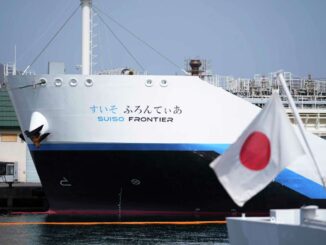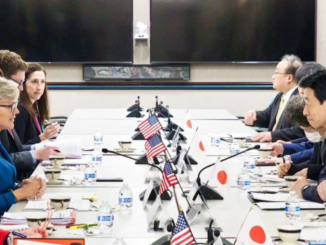
Japan has adopted a new policy promoting greater use of nuclear energy in a major reversal of the phase-out plan that was established following the Fukushima disaster.
Faced with fuel shortages and rising energy prices, the nation has taken the step to end an 11-year prohibition on the building of new nuclear reactors.
The new policy establishes that Japan must maximise the use of existing nuclear reactors by restarting as many of them as possible, prolonging the operating life of old reactors beyond their 60-year limit, and developing next-generation reactors to replace them.
The policy document describes nuclear power as serving “an important role as a carbon-free baseload energy source in achieving supply stability and carbon neutrality” and pledges to “sustain use of nuclear power into the future”.
The proposed legislation is thus a total reversal of the nuclear safety measures the country imposed after a powerful tsunami destroyed Fukushima Daiichi’s backup electricity supply, causing three of its six reactors to suffer meltdowns.
For over a decade, the Japanese government has avoided building new reactors or replacing ageing reactors, fearing a public backlash. That was in line with the government’s plan to phase out nuclear energy by 2030.
In the past decade, of the 25 reactors that have applied for restarts, only 10 have resumed operations. However, during an August energy policy meeting, Japanese Prime Minister Fumio Kishida instructed his government to consider developing new nuclear reactors, with a view towards diversifying the nation’s energy sources.
“Green transformation involves a major economic and social transformation, and the technological development and effort by each country can change the situation,” Kishida said, noting that the plans will still need to be approved by Parliament.
The plan drafted by Japan’s Economy and Industry Ministry would allow extensions every 10 years for reactors after 30 years of operation while also permitting utilities to subtract offline periods in calculating reactors’ operational life beyond the current 60-year limit.
The policy was approved on Wednesday by the watchdog Nuclear Regulation Authority, paving the way for the policy to be adopted.
Before the Fukushima meltdowns, about one-third of Japan’s electricity was generated from nuclear sources. In 2020, the figure was less than 5 per cent – but the country’s goal is to raise it to 20-22 per cent by the end of the decade.
Due to the lack of investment on this technology, the majority of the country’s nuclear reactors are over 30 years old. Four reactors that have operated for more than 40 years have received permission to operate, and one is currently online.
However, Japan does not only aim to restart existing reactors. The policy paper made public also expresses the government’s desire to push for the development and construction of “next-generation innovative reactors” with safer features to replace about 20 reactors now set for decommissioning.
Despite past hesitance over the use of nuclear energy, Kishida has, in the past, stated his belief that Japanese voters have become more receptive to nuclear power due to rising fuel costs and a wider commitment to reducing the country’s carbon emissions.
The regulation authority’s commissioner, Shinichi Yamanaka, told a news conference the new safety rules requiring operational permits every decade after 30 years will be safer than a current one-time 20-year extension option for 40-year-old reactors.
However, experts including Takeo Kikkawa, an economics professor at the International University of Japan, disagree. In his opinion, prolonging the operational life of old reactors is unsafe.
“Naturally, we should aim for newer technology and use it safely. Therefore, extending reactors’ lifespans is an undesirable move,” he recently told a talk show.
Other opponents have also pointed out that nuclear power is not flexible and not cheaper than renewables when final waste management and necessary safety measures are considered.
Ruiko Muto, a survivor of the Fukushima disaster, called the new policy “extremely disappointing”.
“The Fukushima disaster is not over yet and the government seems to have already forgotten what happened,” she said.
The updated nuclear policy follows several moves by the Japanese government to promote the use of renewable energy, including the creation of the “GX (Green Transformation) Implementation Council”, which has been asked to compile a new policy that addresses global fuel shortages amid Russia’s war on Ukraine and seeks to achieve carbon neutrality by 2050.
The council adopted plans to make renewables Japan’s main energy source and further promote hydrogen and ammonia as well as offshore wind power and other forms of energy to promote decarbonisation, supply resilience and economic security.
This is a strategy supported by a 2022 report from the International Energy Agency (IEA), which said there was likely no path toward 2050 zero-emissions carbon goals that would not include the use and expansion of nuclear power as a transitional step.
“Nuclear power has the potential to play a significant role in helping countries to securely transition to energy systems dominated by renewables,” the IEA said.
The Fukushima meltdown was considered the worst nuclear disaster since that at Chernobyl, Ukraine, in April 1986, and prompted the declaration of a 30km evacuation zone around the Japanese plant.
Although there were no reported deaths or cases of radiation sickness directly caused by the nuclear accident, over 100,000 people were evacuated from their homes as a preventative measure and many have not returned. Seven years after the disaster, a Greenpeace report found that radiation levels in the area continued to be up to 100 times higher than normal.



